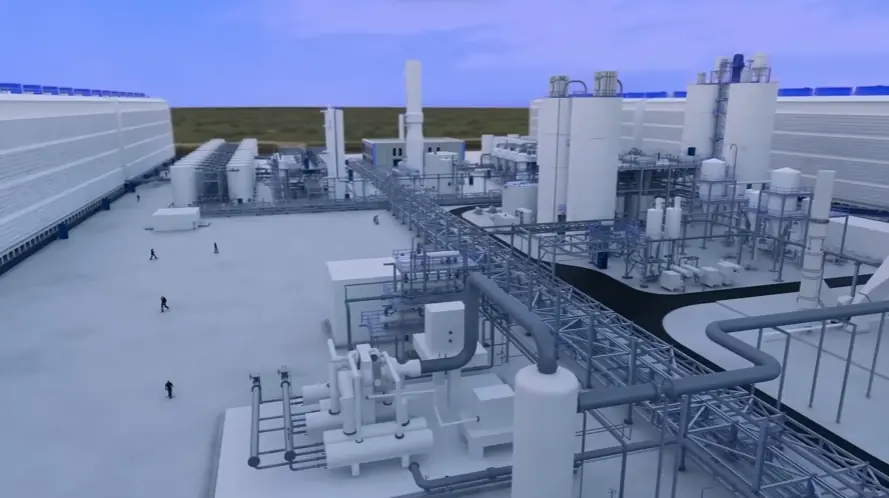How industrial 3D visualizes complex processes
When crafting an Industrial 3D Marketing Video, strategic considerations extend far beyond simply showcasing intricate equipment. They become powerful tools guiding potential clients through a journey. Instead of vague requests, effective videos employ clear, Specific calls to action . Think actionable phrases like " Request a Demo ," "Start Your Free Trial," or "Download the Report," precisely aligned with the video's objective and the viewer's stage in their evaluation process.
Measuring the Return on investment from these visual assets remains paramount. This involves meticulously tracking production expenses against the value generated post-viewing. Tangible value surfaces in various forms: an increase in Qualified leads entering the sales pipeline, a noticeable reduction in the sales cycle length due to better-informed prospects, or fewer support tickets because users gained clarity on complex features directly from the video.
Maximizing impact requires grounding the visuals in reality. Using Real-world scenarios within a product tour demonstrates how a system operates within a user's actual environment. Showing features integrated into existing workflows or solving industry-specific problems dramatically increases perceived value. Analyzing Viewer behavior offers profound insights; tools like heatmaps reveal where viewers focus or drop off, guiding content refinement. Analyzing how viewers interact with a 3d industrial animation offers crucial insights into which parts of a complex sequence resonate most effectively.
Building trust quickly is another key strategy. Incorporating Social proof , such as displaying client logos of well-known companies using the product or sharing statistics on user satisfaction, lends immediate credibility. Continuously refining the approach involves testing different elements.
- A/B test thumbnail images and the opening seconds to optimize initial viewer attraction.
- Experiment with CTA placement and wording to discover what drives the highest conversion rates.
- Test subtle variations in script or pacing to see what resonates most effectively with target audiences.
- Optimize video length and content detail specifically for each platform, considering viewer intent and viewing environment.
Applying these strategic layers transforms visual demonstration s into potent tools driving engagement and Measurable business outcomes .
Visualizing product internal workings with 3D
Beyond showcasing external form, visualizing product Internal workings with 3D empowers potential clients to understand complexity and innovation. Highlighting mechanical precision, internal systems, or assembly processes builds confidence and demonstrates engineering excellence. This perspective moves past surface-level features, offering a deep dive into the value proposition, crucial for high-value industrial equipment and systems where internal functionality drives performance and reliability.
Maximizing the effectiveness of a 3D Industrial Marketing Video requires a strategic approach extending beyond creation. Clear, action-oriented calls to action are paramount. Instead of generic requests, guide viewers precisely toward the next step aligned with their interest level, whether requesting detailed specifications, scheduling a consultation, or accessing a relevant case study. Tailoring these prompts increases the likelihood of conversion.
Measuring the return on investment is essential to justify resources spent on a 3d industrial explainer video. This involves tracking not just production expenses but also tangible results . Metrics such as an increase in qualified leads directly attributed to video views, a measurable reduction in the sales cycle length due to better-informed prospects, or a decrease in technical support queries post-purchase demonstrate clear value and inform future marketing efforts.
- Deploying analytics to track viewer behavior offers invaluable insights. Monitoring where viewers engage most or drop off allows for iterative refinement of the video content, ensuring critical information is retained.
- Incorporating social proof, such as brief displays of recognized client logos or relevant industry certifications, builds immediate trust and credibility with the target audience.
- Employing A/B testing on elements like video thumbnails, introductory scenes, or variations in calls to action helps identify what resonates most effectively and drives higher engagement rates.
- Optimizing video format and content for specific platforms, considering typical viewer intent and environment, ensures maximum reach and impact, from quick social media views to in-depth website explorations.
By focusing on these strategic elements, industrial marketers can transform detailed visualizations into powerful tools that not only explain intricate designs but also actively contribute to achieving business objectives and fostering stronger client relationships.
Explaining complex systems through animation
Explaining intricate industrial systems requires more than just showing parts. Teams utilize animation as a strategic asset, driving clarity and achieving measurable outcomes. Placing clear calls to action at key moments guides viewers effectively. Generic prompts fall short; specific requests like "Request a Demo" or "Download the Report" aligned with the viewer's journey prove far more effective for driving desired next steps. Creating a compelling 3d industrial product video allows showcasing products in real-world scenarios, making solutions relatable and boosting perceived value by demonstrating integration into existing workflows or industry-specific challenges.
Measuring return on investment becomes crucial. They meticulously track production expenses against generated value. Success metrics include increased qualified leads flowing through the pipeline. Observing a reduction in sales cycle length among better-informed prospects demonstrates animation's direct impact. A well-crafted 3d industrial training video can lead to decreased support ticket volume from users understanding features better, also quantifying its value. This focus on tangible results validates the investment in high-quality visuals.
To refine the content and ensure it resonates, analyzing viewer behavior is indispensable. Teams use analytical tools like heatmaps and attention tracking to reveal precisely which segments capture attention, are rewatched, or skipped. This granular data helps pinpoint confusing areas or points where interest wanes, informing iterative improvements. Building credibility often involves incorporating social proof. Brief flashes of well-known clients or statistics about satisfied users build trust rapidly.
Furthermore, optimizing for different platforms considers viewer intent and viewing environments. Social media videos need instant hooks and silent watchability, often shorter. Videos on product pages can afford greater detail, assuming higher intent. Through A/B testing different video elements, they gain significant insights into what resonates most, driving higher conversions. Experimenting with thumbnails, initial content, or CTA variations yields actionable data for continuous optimization .
Showcasing manufacturing workflows effectively
Effectively demonstrating manufacturing workflows requires moving beyond basic visualization to strategic communication . To truly resonate and drive results, teams must focus on presenting processes within real-world scenarios, showing equipment functioning in contexts viewers recognize. This approach makes complex operations relatable and highlights direct value by illustrating how machinery integrates into existing production lines or addresses specific industry challenges.
Analyzing how viewers interact with content provides invaluable insights. Using tools that track attention allows understanding which parts of a workflow demonstration are most compelling and where viewers might become disengaged. Identifying confusing segments through this data enables precise refinement, ensuring the Viewer comprehension remains high throughout the video.
Crafting clear pathways for viewer action is essential for converting interest into tangible results. Generic prompts are far less effective than action-oriented calls tailored to the viewer's stage in their journey. Optimizing content involves testing different elements and adapting the presentation style based on the intended platform, recognizing that attention spans and viewer intent vary significantly between social feeds and dedicated product pages. Ultimately, the goal is often a compelling Industrial 3d product video that demonstrates value by showing the equipment functioning in realistic settings.
- Employ specific calls to action such as "Request a Demo" to guide interested viewers directly.
- Incorporate social proof, like displaying familiar company logos or sharing user statistics, to build immediate credibility and trust.
- Continuously measure video performance by tracking metrics like qualified leads generated or reductions in sales cycle duration to calculate return on investment.
- Conduct A/B testing on visual elements and messaging within the video to refine what most effectively engages the target audience.
Complex processes become crystal clear with 3D Industrial Visualization, allowing viewers to grasp intricate operations effortlessly and appreciate the efficiency gains depicted.
Animating difficult engineering concepts clearly
Moving beyond static diagrams, 3D animation offers a powerful method to communicate intricate technical details and dynamic operations. It allows viewers to virtually step inside machinery or processes, understanding complex interactions that are otherwise hidden from view. This clarity is paramount when introducing innovative engineering solutions or demonstrating sophisticated equipment.
Showing how technology functions within familiar, real-world industrial scenarios elevates viewer comprehension. They see the product not in isolation but as an integrated part of their operational world. Demonstrating seamless integration into existing workflows or highlighting how it solves specific industry pain points makes the value tangible. Showcasing a product's place within a larger system or detailing its construction in an industrial assembly 3d video enhances viewer understanding.
Achieving visual clarity with 3D is just the first step; translating that clarity into measurable business results requires strategic execution. Businesses must guide viewers towards specific, actionable calls to action, moving beyond vague suggestions. These precise prompts, like requesting a demonstration or downloading a detailed report, align the video's purpose with the viewer's stage in their journey. Tracking success involves quantifiable metrics, assessing not just views but qualified leads generated directly from video engagement.
- Evaluate impact on shortening the sales cycle duration by providing prospects with comprehensive visual information upfront.
- Monitor reduction in customer support inquiries, indicating improved user understanding of product features through clear visualization.
- Leverage Viewer engagement data , including heatmaps, to pinpoint compelling sections and identify areas needing refinement based on actual viewing patterns.
- Continually optimize video effectiveness through systematic A/B testing of different visual approaches or calls to action and adapting format for various platforms.
An industrial process 3d video that effectively animates complex operations, paired with clear calls and diligent measurement, transforms technical explanation into a potent tool for driving business growth.
Achieving photorealistic detail in renders
Achieving Photorealistic detail elevates the impact of the industrial 3D video, making Complex machinery or processes feel tangible and real to viewers. This Visual fidelity moves beyond simple representation, creating an Immersive experience that builds immediate credibility and trust. When visuals are indistinguishable from reality, they effectively communicate value.
Presenting products within realistic operational environments increases perceived value and relatability. Accurate material properties, conveyed through precise texturing and lighting, allow audiences to intuitively grasp product quality and function, crucial for showcasing intricate components in applications like 3D assembly animation. This believable context strengthens the power of social proof elements displayed alongside the visuals, making testimonials or client logos more convincing.
High visual fidelity holds audience attention longer, generating richer data for viewer analytics tools such as heatmaps. This granular information reveals exactly which realistic visual elements resonate most, guiding optimization efforts. Testing variations in rendering style or specific visual cues becomes a powerful approach in A/B testing to determine maximum engagement and clarity across different target audiences.
Ultimately, the clarity and trust fostered by photorealistic rendering contribute directly to measurable business outcomes. Effective, action-oriented calls to action are more persuasive when viewers have confidence in the capabilities demonstrated visually. Measuring return on investment involves tracking metrics influenced by this enhanced clarity, such as increased qualified leads, a shorter sales cycle due to better-informed prospects, and a potential decrease in support inquiries as users gain deeper understanding from the outset. Optimizing the level of photorealistic detail for diverse platforms ensures this impact is consistently delivered regardless of viewing environment.
Demonstrating equipment function without physical models
Producing compelling industrial marketing videos demonstrating equipment function without physical models offers significant advantages. They allow audiences to explore complex machinery with clarity and detail impossible through traditional methods. Visualizing internal workings, mechanical processes, and operational sequences helps bridge technical understanding gaps for diverse stakeholders. This approach enables showcasing equipment performance within simulated, Realistic contexts , highlighting problem-solving capabilities and integration into existing operations.
Effective videos employ specific calls to action guiding viewer engagement. Instead of generic prompts, action-oriented text prompts viewers towards defined next steps aligned with their buyer journey stage. Analyzing viewer behavior provides critical insights, showing which parts of a demonstration resonate most or where interest might decline. Utilizing tools revealing watch patterns helps refine content for Maximum impact and retention.
Incorporating social proof elements builds immediate credibility. Brief inclusion of recognized client logos or statistics about user adoption reinforces trust. Optimizing videos for distinct platforms ensures maximum reach and effectiveness, recognizing different viewing environments and audience intent, sometimes requiring adaptations like text overlays for sound-off viewing.
- Measure return on investment by tracking production costs against generated value.
- Quantify value through metrics like increased qualified leads or reduced sales cycles.
- Implement A/B testing on video elements like thumbnails or call to action placement.
- Refine video content based on Viewer data , improving clarity and engagement points.
How 3D models large infrastructure projects
Visualizing large infrastructure projects demands a different level of detail and clarity. Stakeholders, from investors and engineers to public officials, require precise, digestible information to make critical decisions. Employing advanced 3D modeling transforms complex blueprints and data into understandable visual narratives, essential for gaining alignment and approvals on massive undertakings.
Successfully communicating the scope and intricacies of these builds bridges communication gaps inherent in multi-faceted projects spanning years. Demonstrating intricate construction phasing or showcasing structural design nuances becomes intuitive. For instance, clarity on complex construction timelines is significantly enhanced through a well-crafted 3D explainer video , simplifying intricate sequences for diverse audiences involved.
- Crafting clear calls to action tailored to specific viewer needs guides engagement effectively through the project lifecycle.
- Measuring success tracks tangible outcomes like reduced time in review cycles or increased participation in public consultations, directly linking visual investment to project progress.
- Incorporating real-world geographic data grounds the visuals, boosting confidence in the project's viability and accurate integration within its environment.
- Detailing key operational elements within a structure, perhaps showing critical machinery functions using 3D factory animation, assures technical reviewers of system capabilities and operational logic.
Analyzing how different stakeholder groups interact with these visuals, coupled with A/B testing various communication approaches, allows project teams to continually refine their messaging and achieve project milestones faster.
Creating persuasive visuals for B2B industrial buyers
To truly influence B2B industrial buyers, visuals must move beyond mere explanation to active persuasion. While demonstrating complex systems with clarity is foundational, the goal becomes guiding that informed prospect towards a decision. This requires a strategic approach to the visual narrative and its accompanying elements. They aim to not just showcase capability but build confidence and demonstrate tangible value relevant to the buyer's operational needs and challenges.
Consider how specific tactics can enhance the persuasive power of a 3D Machinery Animation or a comprehensive 3d machinery video. Measuring the impact goes beyond views; it involves tracking costs against value generated, like increased qualified leads or a reduced sales cycle length due to better-informed prospects. Showing products within real-world scenarios, demonstrating seamless integration into existing workflows, significantly boosts relatability and perceived value.
Analyzing viewer behavior provides invaluable data. Tools like heatmaps reveal exactly which parts viewers watch or skip, identifying confusing segments or points where interest wanes. Incorporating social proof, perhaps showing well-known company logos or mentioning user statistics, builds immediate credibility and trust. Continuous refinement through A/B testing elements like the opening content or CTA wording yields insights into what truly resonates and drives conversions.
- Use clear, specific calls to action. Generic prompts like "Learn More" are less effective than action-oriented text such as "Request a Demo" or "Download the Report," tailored to the video's objective and viewer journey stage.
- Optimize visuals for different platforms. Social media demands instant attention and often understanding without sound, using text overlays, while product pages allow for longer, more detailed content assuming higher viewer intent.
- Ensure the narrative focuses on solving problems specific to the buyer's industry or daily tasks, increasing perceived value.
- Leverage data from viewer interactions to iterate and improve content, making each visual more effective than the last.
Strategically implemented, persuasive visuals become powerful tools, turning complex information into confident action for industrial buyers.
Visualizing critical safety features compellingly
Complex processes demand sophisticated visual explanation; here 3D Manufacturing Animation proves invaluable. Visualizing safety features requires showing mechanics impossible live-action. Complex machinery operations, emergency shutdown procedures, lockout tagout steps demand absolute clarity. Ambiguity safety information costs lives. Compelling visuals prevent incidents ensure correct protocol execution.
Ultimately compiling this visual information into cohesive 3d manufacturing video crucial communication channels. This output serves Training materials , Marketing assets highlighting product safety excellence. Viewers need direction after watching. Clear specific calls action vital. Generic prompts like "Learn More" lack impact.
Action-oriented text guides viewers next step. "Start Your Free Trial," "Request Demo," "Download Report" examples. Align CTA viewer journey stage. Measuring video success quantifies impact. Track production cost against generated value. Value metrics include lead quality gains, reduced sales cycle length.
- Value metrics include fewer support queries users understood features.
- Ground safety features relatable scenarios. Demonstrate product function industry contexts increases perceived value. Using real-world scenarios makes product tour relatable believable.
- Viewer analytics reveal engagement patterns. Heatmaps attention tracking show watching, rewatching, skipping. This granular data invaluable identifying confusing segments.
- A/B testing refines video elements performance. Test thumbnail, initial content, CTA placement wording. Yields significant insights resonates most target audience drives higher conversions.
Ensuring safety messages resonate across platforms requires optimization. Videos social feeds grab attention instantly, understandable sound, shorter. Video product page assumes higher intent, detailed. Incorporating social proof builds credibility trust. Brief flashes well-known company logos statistics satisfied users persuasive.




































